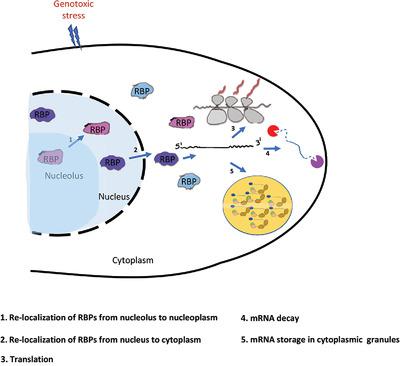Our official English website, www.x-mol.net, welcomes your
feedback! (Note: you will need to create a separate account there.)
Genotoxic stress response: What is the role of cytoplasmic mRNA fate?
BioEssays ( IF 3.2 ) Pub Date : 2021-06-07 , DOI: 10.1002/bies.202000311 Gayatri Mohanan 1 , Amiyaranjan Das 1 , Purusharth I Rajyaguru 1
BioEssays ( IF 3.2 ) Pub Date : 2021-06-07 , DOI: 10.1002/bies.202000311 Gayatri Mohanan 1 , Amiyaranjan Das 1 , Purusharth I Rajyaguru 1
Affiliation

|
Genotoxic stress leads to DNA damage which can be detrimental to the cell. A well-orchestrated cellular response is mounted to manage and repair the genotoxic stress-induced DNA damage. Our understanding of genotoxic stress response is derived mainly from studies focused on transcription, mRNA splicing, and protein turnover. Surprisingly not as much is understood about the role of mRNA translation and decay in genotoxic stress response. This is despite the fact that regulation of gene expression at the level of mRNA translation and decay plays a critical role in a myriad of cellular processes. This review aims to summarize some of the known findings of the role of mRNA translation and decay by focusing on two categories of examples. We discuss examples of mRNA whose fates are regulated in the cytoplasm and RNA-binding proteins that regulate mRNA fates in response to genotoxic stress.
中文翻译:

基因毒性应激反应:细胞质 mRNA 命运的作用是什么?
基因毒性压力会导致 DNA 损伤,这可能对细胞有害。一个精心策划的细胞反应被用来管理和修复基因毒性应激引起的 DNA 损伤。我们对基因毒性应激反应的理解主要来源于专注于转录、mRNA 剪接和蛋白质周转的研究。令人惊讶的是,人们对 mRNA 翻译和衰变在基因毒性应激反应中的作用了解不多。尽管事实上在 mRNA 翻译和衰变水平上对基因表达的调节在无数细胞过程中起着关键作用。本综述旨在通过关注两类示例来总结一些关于 mRNA 翻译和衰变作用的已知发现。
更新日期:2021-07-23
中文翻译:

基因毒性应激反应:细胞质 mRNA 命运的作用是什么?
基因毒性压力会导致 DNA 损伤,这可能对细胞有害。一个精心策划的细胞反应被用来管理和修复基因毒性应激引起的 DNA 损伤。我们对基因毒性应激反应的理解主要来源于专注于转录、mRNA 剪接和蛋白质周转的研究。令人惊讶的是,人们对 mRNA 翻译和衰变在基因毒性应激反应中的作用了解不多。尽管事实上在 mRNA 翻译和衰变水平上对基因表达的调节在无数细胞过程中起着关键作用。本综述旨在通过关注两类示例来总结一些关于 mRNA 翻译和衰变作用的已知发现。











































 京公网安备 11010802027423号
京公网安备 11010802027423号